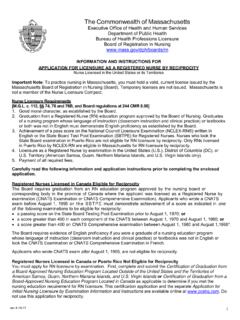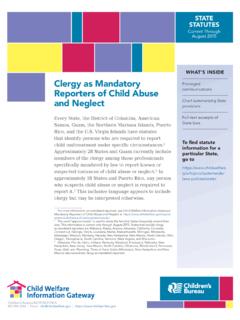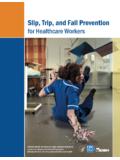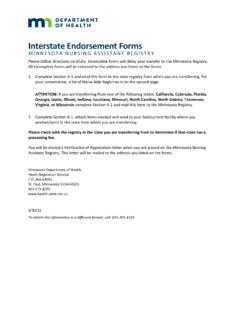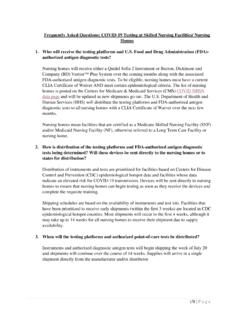Transcription of SBIRT TK-SA3522 SinglePage - MASBIRT TTA | Massachusetts ...
1 A Step-By-Step GuideSBIRT:A Step-By-Step Guide for Screening and Intervening for Unhealthy Alcohol and Other Drug UseClinician s ToolkitClinician s ToolkitThis toolkit was developed to assist Massachusetts healthcare providers and organizations in implementing regular Screening, Brief Intervention and Referral to Treatment ( SBIRT ) for unhealthy alcohol and drug use in clinics and practices. SBIRT is a quick, easy way to identify and intervene with patients whose patterns of use put them at risk for, or who already have, substance-related health problems. How much time is needed?Most patients (75-85%) will screen negative. Completing 3-4 simple questions will take 1-2 minutes. For the remaining 15-25% of patients, the full screen and brief intervention will take between 5 - 20 minutes to complete. This toolkit provides: 9H[PVUHSL MVY YV\[PUL ZJYLLUPUN MVY \UOLHS[O` HSJVOVS HUK KY\N \ZL HZ HU PTWVY[HU[ JVTWVULU[ of good healthcare ;^V YLJVTTLUKLK screening approaches for alcohol and other drug use ( Z\NNLZ[LK brief intervention script :[LWZ MVY referring patients to substance use specialty care, when needed 8\LZ[PVUZ [V JVUZPKLY MVY implementing SBIRT Helping Patients Who Drink Too Much: A Clinician s Guide, produced by the National Institute on Alcohol Abuse and Alcoholism (NIAAA).)]]]]]]]]]]
2 Of particular note, is the section on Prescribing Medications For Treating Alcohol Dependence , as well as suggested strategies to diagnose and help patients with alcohol use further information or to arrange SBIRT training and implementation assistance, please contact the Massachusetts department of public health bureau of Substance Abuse Services SBIRT Coordinator at 8\LZ[PVUZ ):(:'Z[H[L TH \Z About this ToolkitSBIRT focuses on the large numbers of people who may use alcohol or drugs in unhealthy ways but who do not have a substance use disorder ( , abuse, dependence). Research shows that they can and do successfully change their use with feedback and early intervention. SBIRT also gives positive feedback to those who make healthy decisions. 1,2,3,4 What is SBIRT ? 1 SBIRT in ActionScreen (S): Ask and Assess 4 Standard Approach: A more rigorously validated approach Quick Approach.]]]
3 Easier to memorizeBrief Intervention (BI) 9 Referral to Treatment (RT) 11 Special Privacy Regulations and Patient Consent 12 Supplemental Information10 Questions to Consider Before Implementing SBIRT 14 Consent Form Allowing Addiction Treament Providers to Communicate 16 NIDA Commonly Abused Drugs Chart List of commonly abused drugs and their acute effects 18 Brief Intervention Q&A 20 Motivational Interviewing Overview 22 SBIRT Considerations for Special Populations 26 CAGE Screening Tool in Spanish 27 NIAAA Clinician s Guide Helping Patients Who Drink Too Much (see back pocket)Table of Contents1 Screening, Brief Intervention and Referral to Treatment ( SBIRT ) is a comprehensive, integrated, public health approach for early identification and intervention with patients whose patterns of alcohol and/or drug use put their health at risk.
4 SBIRT components are:s 5 NIVERSAL ANNUAL Screening (S) identifies unhealthy use. 75-85% of patients will screen negative. For those who screen positive, further assessment is needed to determine level of risk. s Brief Intervention (BI) provides feedback about unhealthy substance use. It also focuses on education, increasing patient insight and awareness about risks related to unhealthy substance use, and enhances motivation toward healthy behavioral change. s Referral to Treatment (RT) helps facilitate access to addiction assessment and treatment. A referral is usually indicated for only about 5% of people shows SBIRT to be most effective with patients with unhealthy alcohol or drug use who do not have a substance use What is SBIRT ?Source: SAMHSA funded MASBIRT program, N=173,714 Require brief interventionRequire referral to treatmentOnly require screeningWhat is Unhealthy Alcohol or Drug Use?
5 Substance use (alcohol and drug) occurs on a continuum from no or low risk use to substance use disorders. Effective interventions are available for people at all points on that continuum. In most cases, unhealthy substance use issues can, and should, be addressed in general healthcare SUBSTANCE USE IS AN ALL ENCOMPASSING TERM that includes the full spectrum of unhealthy use from:s 2 ISKY USE I E CONSUMPTION OF AMOUNTS THAT increase the likelihood of health consequences)s 3 UBSTANCE USE DISORDERS I E ABUSE AND dependence)Some people should not drink at all. For more information about unhealthy alcohol use see p. 24 and 25 of the NIAAA Clinician s Guide included at the back of this use of illegal drugs or misuse of prescription drugs is considered unhealthy DrinkingFor healthy men up to age 65 s -ORE THAN 4 drinks in a day ANDs -ORE THAN 14 drinks in a weekFor all healthy women and healthy men over age 65s -ORE THAN 3 drinks in a day ANDs -ORE THAN 7 drinks in a weekAs recommended by NIAAAU nhealthy Alcohol and Drug UseSUD*Risky UseNo or low risk 3 UBSTANCE 5SE $ISORDERS1.
6 Decide who will do SBIRT ( clinician, support staff) and, if more than one person is involved, determine the Communicate with your clinic management about how your practice will handle billing potential, documentation requirements and confidentiality regulations. 3. This toolkit was designed to help providers identify unhealthy use, rather than diagnose substance use disorders. For patients who may need further assessment and diagnosis, see NIAAA Clinician s Guide page 7, step 3, or refer to THE CURRENT VERSION OF THE $3- 4. Identify referral resources in your area through your behavioral health staff or by CALLING THE -ASSACHUSETTS 3 UBSTANCE !BUSE )NFORMATION AND %DUCATION (ELPLINE AT 3EE THE 2 EFERRAL SECTION ON P FOR MORE INFORMATION -OST insurance coverage includes counseling for substance use disorders. See supplemental p.
7 14 for additional considerations for YOU BEGINWhy Universally Screen and Intervene? 5 NHEALTHY ALCOHOL AND OTHER DRUG USE ARE AMONG THE MOST COMMON CAUSES OF PREVENTABLE MORBIDITY AND Despite their frequent presentation in primary care, unhealthy alcohol and other drug use often go unrecognized. While there is substantial research on SBIRT and alcohol, there is less research on SBIRT and ,85 NHEALTHY SUBSTANCE USE CAN COMPLICATE EXISTING CHRONIC CONDITIONS LIKE DIABETES 9 hypertension,10,11 cardiovascular diseases or mental health disorders11 and interact with prescribed ,14 Research has shown that large numbers of people whose patterns of use put them at-risk of developing alcohol or drug problems can be identified through has also been found to:s DECREASE THE FREQUENCY AND SEVERITY OF DRUG AND ALCOHOL USE16-18s DECREASE EMERGENCY department VISITS AND HOSPITAL DAYS19s DEMONSTRATE NET COST SAVINGS19-223 SBIRT in Action4 Alcohol only: Go to NIAAA Clinician s Guide located at the back of this and Drug: (Proceed ahead)We recommend two substance use screening strategies: t The Standard Approach on p.
8 5-7 is longer and requires scoring but has been more rigorously TESTED FOR VALIDITY 7E RECOMMEND THIS STRATEGY WHEN INCORPORATING QUESTIONS INTO YOUR %-2 t The Quick Approach on p. 8 may be preferable to some as it is easy to memorize, is validated, and can be completed within a few minutes. These questions are like other tests in medical practice and have been validated as such. They may not work as well if altered. Recommended screening and assesment instruments have high sensitivity and , 23, 24, 25, 26,27 All practices should routinely incorporate tobacco screening. Ask all patients about tobacco use and readiness to quit. QuitWorks ( ) is a resource for providers to help patients quit. Providers can also go to for information on prescribing medications for tobacco addiction and other universally screening, some people who don t use alcohol or drugs may disclose that they are in recovery and working to maintain their health in spite of an addiction.
9 This provides an opportunity to: s CONGRATULATE THE PATIENT s ASK HOW LONG S HE HAS BEEN IN RECOVERY s ASK whether s/he attends peer support groups or needs counseling or other support s ASK WHAT n IF ANY n CONCERNS THIS MAY RAISE in relation to prescription medications, or other medical issues s ask about tobacco use as this is a major cause of death for people in recovery28 PATIENTS IN RECOVERYSTEP 1: Ask about alcohol & drug useScreen (S): Ask and Assess5 STANDARD APPROACH (Ideal for screening when questions can be integrated into the EMR)Alcohol Use A drink is defined as: 12 ounces of beer, 5 ounces of wine, or ounces of spirits. See NIAAA Clinician s Guide, p. 0 1 2 3 4 Score (OW OFTEN DO YOU HAVE .EVER -ONTHLY TIMES TIMES OR MOREa drink containing alcohol? or less a month a week times a week _____ (OW MANY DRINKS CONTAINING OR OR OR TO OR MORE ?))
10 ????alcohol do you have on atypical day when you are drinking?3. (OW OFTEN DO YOU HAVE lVE OR .EVER ,ESS THAN -ONTHLY 7 EEKLY $AILY OR ?????more drinks on one occasion? monthly almost daily If negative, reinforce their healthy positive, go to STEP 2B to assess with the DAST-10 on p. 7. Your patient has at least RISKY drug use. SCORING*17/-%. -%.Drug UseSingle-item drug screen(OW MANY TIMES IN THE PAST YEAR HAVE YOU USED AN ILLEGAL DRUG OR USED A PRESCRIPTION MEDICATION for non-medical reasons? (If asked what non-medical reasons means you can say because of the EXPERIENCE OR FEELING THE DRUG CAUSED If negative, reinforce their healthy decisions and continue with drug positive, go to STEP 2A to assess with the full AUDIT on p. 6. Your patient has at least RISKY alcohol use. SCORING* 3 7/-%.* 4 -%.Drug UseSingle-item drug screen(OW MANY TIMES IN THE PAST YEAR HAVE YOU USED AN ILLEGAL DRUG OR USED A PRESCRIPTION MEDICATIONfor non-medical reasons?))))
